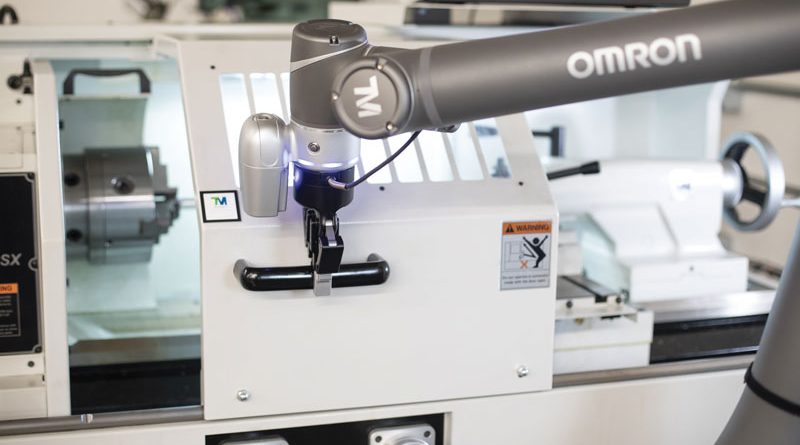The Key Role of Cobots in Production
Cobots are versatile and can be used in numerous applications. With an integrated and intelligent image processing system, users can benefit from further advantages that will improve production processes. Omron explains how
Collaborative robots (cobots) have a key role in current and future trends in industrial automation and production. Recent studies from Loup Funds assume that the value of cobots in industrial automation will have reached 7 billion dollars by 2025. With the average retail price of a cobot being between 15,000 and 45,000 dollars, their use in this type of automation is also becoming increasingly feasible for industrial manufacturing applications in smaller facilities and warehouses.
However, companies that are developing innovative and integrated cobot concepts must meet a wide range of requirements. To increase production flexibility, efficiency and quality, they will need to carefully develop the interaction between mobile robots, cobots and other elements – such as integrated apps, support and risk assessment, and camera and vision technology. But what key aspects do companies need to consider, and what are the best ways of using smart camera and image processing systems with cobots?

What tools to choose in order to aid cobot movements
For applications in which flexibility and quality are more important than speed, cobots can be combined with user-friendly software tools and integrated sensor functions. Examples include machine vision systems that have localisation options.
Some cobots can navigate using a landmark tool. The marking is easily recognised by the robot’s built-in camera, and can be used as a reference point for its movements. This enables it to know how to move to the correct positions, which is particularly helpful when objects or devices are moved during production, or when the cobot is transferred to another workstation.
The important of vision systems to improve quality control
Companies need easy-to-use, intelligent camera and image processing systems that will recognise patterns, carry out quality control, place objects and identify barcodes. For example, organisations in the food and drinks, pharmaceuticals and medical device sectors have to meet both high consumer expectations about safety as well as strict legal requirements.
For instance, one pressing need is for vision systems that can check whether the information on a label or packaging is correct, and complies with the consumer’s information requirements. When implementing cobots, it therefore makes sense to integrate image processing systems into the cobot to optimise traceability and logging protocols. Another advantage is its flexible scalability, based on the needs of the user. For example, it’s possible to start with a simple integrated system and then expand it as required. Smart systems based on Artificial Intelligence (AI) or Machine Learning (ML) can also help to enhance decision-making through the use of data visualisation.

AI at the edge allows to increase accuracy
Industry 4.0 and the IIoT enable historical data to be recorded and used for process improvements. However, many AI projects have problems with visualising new information. Fortunately, control solutions that are linked to predictive maintenance, such as Omron’s AI controller, can merge the control functions of production lines and systems with AI processing in real time.
Today’s production facilities increasingly require in-depth knowledge combined with data that’s generated and collected at the machine level – i.e. at the edge. For example, a machine can learn from its human operators and improve its performance, as well as that of cobot applications. AI-driven technology can predict both product and device failures, based on data from IIoT devices. The analysis of combined data enables the rapid prediction of machine errors, which in turn prevents plant downtime and product quality issues.
The AI controller can generate and evaluate data that can be time-stamped and easily visualised. Raw data acquisition is fully automated “at the edge”, leading to higher data accuracy and consistency. In addition, the controller automatically creates data models from the correlation analysis and uses these to monitor the machine’s status.

A peek into the factory of the future
Omron’s TM cobot provides a practical example of how camera and image processing technology can be integrated into a cobot. It can be used, for example, for applications in assembly, packaging, inspection and logistics. The built-in five-megapixel camera and the integrated vision system provide some clear benefits. The image processing system is designed for pattern recognition, object recognition and positioning, as well as colour classification and barcode identification. The task designer software enables users to set up tasks for immediate use without having to install additional cameras or lighting.
The Omron TM’s integrated camera has an autofocus function that can locate objects in variable fields of view and at different distances. Overall, therefore, the image processing system improves the reliability, consistency and accuracy of the application. Cobots can bring the flexible factory of the future to life by enabling machines and people to work side by side, and almost hand-in-hand. As part of a complete package that includes mobile robots, image processing technology, risk management and security services, cobots can bring considerable advantages to manufacturing and industrial companies. The latest cobots are safer, simpler to program and easier to integrate into other systems. They can therefore make a significant contribution to the development of an intelligent and future-oriented manufacturing environment.

